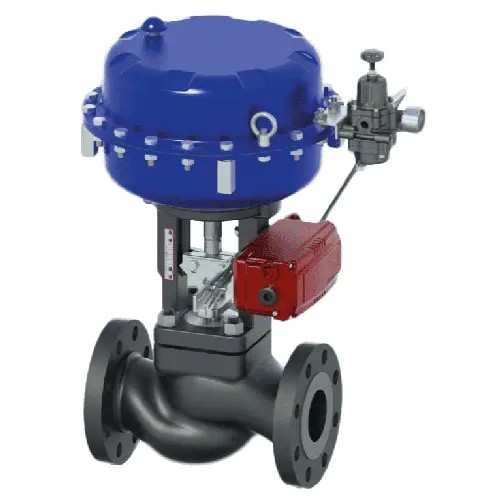Introduction
We are a leading control valve manufacturer in China, delivering high-quality valves and control actuators designed to meet a wide range of industrial applications.
Control valves are vital components in industrial processes, tasked with precisely regulating fluid flow, pressure, and temperature across a diverse range of applications. With continual advancements in valve technology, modern control valves are engineered to meet the stringent demands of fossil power plants, oil and gas facilities, and other industrial environments. They are particularly well-suited for semi-severe service applications requiring specialized trims such as anti-cavitation or low-noise designs. High-pressure drops common in these processes often present challenges like erosion, noise, and vibration, which can degrade process control and overall plant efficiency. To overcome these challenges, control valves are designed with robust construction and advanced features to ensure reliable operation and extended service life.
Typical applications include heater drains, condensate water systems, steam services, spray water systems, level control, pressure regulation, and flow management. Their versatility and adaptability make control valves indispensable for maintaining safe, efficient, and stable operations across many industries.
Control Valves
Design and Construction
Modern control valves incorporate cutting-edge design principles that prioritize flexibility, durability, and ease of maintenance. The valve body’s rigid structure minimizes plug vibration, ensuring stable and consistent performance throughout the valve’s travel range. The design accommodates a variety of trim types, allowing customization to suit specific process requirements. Additionally, the screwed seat design facilitates quick repair and trim replacement, minimizing downtime and reducing maintenance costs.
Key design features include:
- Multi-Spring Actuator Design: Enhances hysteresis and dead band performance, delivering precise control and quick responsiveness.
- Proven Trim Design: Features a single P-port and drilled-hole cage optimized for efficient flow control and noise reduction.
- Fail-Safe Modes: Options for fail-to-close or fail-to-open provide safety and reliability during air supply interruptions.
- Screwed Seat Design: Allows full internal inspection and maintenance by simply removing the bonnet, simplifying service procedures.
- Accessories: Comprehensive options such as positioners, limit switches, and solenoid valves enable tailored operation.
Benefits of Control Valves
Control valves offer numerous advantages that make them suitable for both general and highly specialized applications:
- Tight Shutoff: Available with shutoff classes from ANSI IV to VI, ensuring leak-free operation and compliance with stringent sealing requirements.
- Versatile Actuation: Multiple actuation methods—including pneumatic, electric, and hand-wheel—provide operational flexibility.
- Ease of Maintenance: Top-entry design enables quick inspection and trim changes, reducing downtime and maintenance costs.
- Flexible Trim Design: Simple plug changes allow switching between reduced and full capacity trims, or between linear and equal percentage flow characteristics, enhancing adaptability.
- Corrosion Resistance: Wide range of body and trim materials, including NACE-compliant alloys, ensure compatibility with corrosive fluids and sour gas environments.
Applications of Control Valves
Control valves are extensively used across many industrial sectors to address specific process needs, such as:
- Heater Drains: Regulate condensate flow from heaters, optimizing heat transfer and preventing water hammer.
- Condensate Water Systems: Maintain proper water levels in condensate loops to improve steam cycle efficiency.
- Steam Services: Manage steam flow and pressure in boilers and turbines, ensuring safe and efficient operation.
- Spray Water Systems: Precisely control spray water in cooling and desuperheating applications to maintain target temperatures.
- Level Control: Maintain consistent fluid levels in tanks and vessels to avoid overflow or dry running.
- Pressure Control: Stabilize system pressure to protect equipment and maintain process stability.
- Flow Control: Modulate fluid flow to optimize process efficiency and product quality.
Advanced Features and Innovations
Modern control valves integrate advanced technologies that boost performance and reliability:
- Anti-Cavitation Trim: Minimizes cavitation effects, reducing noise, vibration, and erosion, thereby extending valve life.
- Low-Noise Trim: Ensures quiet operation in noise-sensitive applications without compromising flow control.
- Digital Positioners: Provide precise valve positioning with real-time feedback to enhance control accuracy.
- Smart Valve Technology: Embedded sensors and communication capabilities support remote monitoring, diagnostics, and predictive maintenance, reducing unplanned downtime.
Material Selection and Compliance
Material choice is critical to valve durability and performance. Depending on the application, control valves are manufactured from carbon steel, stainless steel, alloy steels, and specialty alloys like Hastelloy and Inconel. These materials offer resistance to corrosion, erosion, and high temperatures, ensuring reliable function in harsh conditions.
Compliance with industry standards is equally important. Valves used in sour gas or corrosive service must meet NACE MR0175/ISO 15156 requirements for sulfide stress cracking resistance. Additionally, adherence to ANSI, ASME, and API standards guarantees safety, reliability, and compatibility within industrial systems.
Installation and Maintenance
Optimizing control valve performance and lifespan requires proper installation and maintenance:
- Correct Sizing: Prevents problems like excessive pressure drops, cavitation, and noise by matching valve size to process conditions.
- Proper Alignment: Ensures correct positioning of the valve and piping to avoid premature wear and operational issues.
- Regular Inspection: Detects potential issues early, reducing the risk of unexpected failures.
- Timely Maintenance: Includes replacing worn parts, lubricating moving components, and cleaning internal surfaces to sustain peak performance.
Conclusion
Control valves are essential for precise flow, pressure, and temperature regulation in a wide array of industrial processes. Through ongoing advancements in design, materials, and smart technologies, modern control valves deliver enhanced performance, reliability, and maintainability. Their capability to handle demanding conditions—such as high-pressure drops, corrosive fluids, and sour gas environments—makes them the preferred choice for fossil power plants, oil and gas operations, and numerous other industries.
By selecting the right valve for each application and following best practices in installation and maintenance, operators can ensure safe, efficient, and cost-effective process control. As technology continues to advance, control valves will remain pivotal in driving industrial innovation, sustainability, and operational excellence. Learn more about Google SEO.





Comments